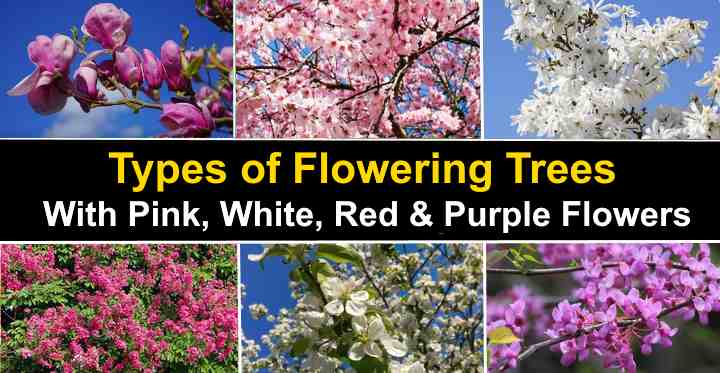Any huge or tiny garden can be enhanced with flowering trees, which bring exquisite pink, red, purple, or white hues. You may have a variety of tree blossoms throughout the spring, summer, and autumn if you prepare your garden landscape properly.
The additional benefit of producing delicious fruits is found in certain flowering fruit trees, such as apple, pear, and cherry trees. When they bloom in the spring, other popular tree types offer you vibrant colors. You’ll learn about some of the most popular types of flowering trees for your garden in this article.
These flowering trees’ photographs and descriptive names will help you choose the right tree for your landscaping requirements.
Types of Flowering Trees with Name and Picture
When flowering trees bloom, their blossoms transform your yard into a sea of color. Any garden, large or small, can benefit greatly from a few well-placed landscape trees.
Trees may provide cover, protection, and even a gigantic fruit harvest when they aren’t in bloom. Your growing zone, how tall the tree grows, and when it blooms must all be taken into account when picking an ideal flowering tree.
There are several dwarf hybrid flowering trees available if you have a tiny, compact garden. After your trees have grown up, they will need very little care, and you can enjoy their beautiful blossoms for years to come.
Types of Pink Flowering Trees (With Pictures)
Magnolia
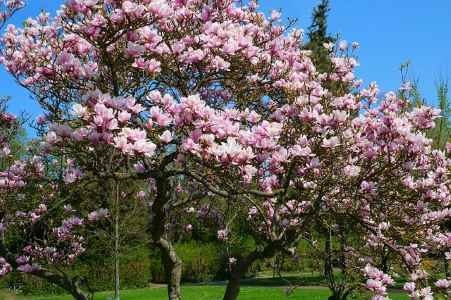
The most commonMagnolia trees are big pink or white blossoms. Magnolias produce lovely pink, mauve, rosy-purple, white, and red blooms when they bloom in the spring. Magnolia blossoms are huge and fragrant, and they’ll enhance your garden’s beauty, elegance, and charm.
Magnolias’ fragrant flowers bloom before their leaves, which is one of the plant’s lovely characteristics. Magnolia blooms are typically very huge and cup- or saucer-shaped, depending on the species. The giant pink blossoms may grow to be up to 12 inches (30 cm) broad. 4″ (10 cm) blooms are possible for some of the smaller light-pink blooms.
Magnolia blooming trees may reach heights of up to 40 feet (12 meters). If you have a smaller garden, choose a dwarf variety that grows to be up to 12 feet (3.6 meters) tall. In zones 4 through 9, magnolias flourish; however, some species only flourish in warmer conditions.
Flowering Cherry Trees

Many people believe that blooming cherry trees are the most gorgeous of the spring flowering trees, with pinkish-white flowers. The Japanese cherry tree (Prunus serrulata) bears lovely light pink and white blossoms that are also known as sakura. Rather than producing fruit, varieties of blooming cherry trees are primarily grown for their spectacular floral blossoms.
Cherry blossoms are one of the earliest flowers on trees to bloom in the spring, similar to magnolias. The ruffled blooms make beautiful clusters on the little 5-petal flowers. These blooms make the tree look like it’s covered in pinkish-white candy floss from afar.
Cherry blossom trees may have a short flowering season. The trees’ petals may disappear after blooming in 2 to 3 weeks. You may, however, extend the blossoming period of cherry blossom trees by planting a range of them that bloom at various times.
An ornamental blossoming cherry hybrid is a good choice if you have a small or compact garden. ‘Kojo-No-Mai,’ a little cherry blossom tree cultivar, grows to a height of 7 feet. Early in the spring, it grows to be tall (2.1 m) and blooms in a pale pink color. In zones 4–9, flowering cherry trees flourish in full sun and develop swiftly.
Eastern Redbud (American Redbud)
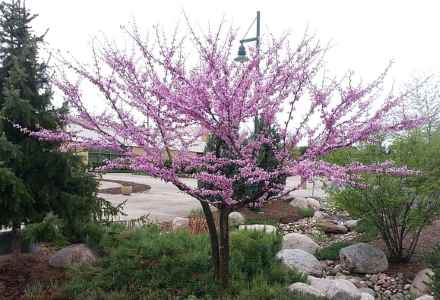
From spring to summer, the Eastern Redbud (Cercis canadensis) is a tiny deciduous tree that bears pink and dark magenta blooms. Eastern redbuds bloom before the foliage emerge, much as magnolias do.
The crimsonbud tree’s flower clusters are a dazzling display of masses of tiny rosy-pink blossoms in the form of pea. The tree has a spectacular appearance owing to the thin flower-covered branches that grow in all directions. Many pink blooms bloom on the tree, adding to the excitement.
Although the pink flowers of eastern redbud trees are well-known, there are some varieties that bloom white as well. Eastern redbud trees may grow to be 20 to 30 feet (6 to 9 meters) tall and 33 feet (10 meters) wide.
A little dwarf tree like the ‘Ace of Hearts’ (only grows to 9 feet (2.7 meters) tall) is ideal for smaller gardens. Zones 5 through 9 are ideal for growing redbuds.
Pink Trumpet Tree
Pink trumpet tree (Tabebuia heterophylla) is a semi-deciduous tree with pink flowers that produces huge clusters of blooms. The tree can stay green all year in warm tropical areas.
The delicate pinkish-white petals of the flowers on the pink trumpet tree have a yellow center. A bushy flower head is formed by clusters of little trumpet-shaped blooms. The tree has a lovely look in any garden because of its wide spreading nature of the branches.
A pink trumpet tree can offer shade and lovely pink hues when planted near a patio or deck during the summer. In subtropical zones, pink trumpet flowering trees (Tabebuia trees) flourish and can grow in both arid and moist conditions.
Persian Silk Tree or Mimosa Tree (Albizia Julibrissin)

The Persian silk tree (Albizia julibrissin) is a summer blooming tree with fragrant fluffy pink and white flowers that is sometimes referred to as “mimosa.” Trees from the genus Mimosa should not be confused with Persian silk trees. Both trees’ flowers appear to be identical, however they come from separate genera.
Mimosa silk trees have drooping fern-like leaves and long spreading branches. The tree is adorned with fragrant pink and white blooms from early summer until mid-summer. These spiky-looking blooms produce a delicate floral fragrance in the warm sun.
Mimosas have unique flowers in comparison to other types of tree flowers. A group of three pink stamens, each about 3 cm long, make up this cluster. On light-green bipinnate-shaped leaves, these develop into powderpuff flowerheads that are fluffy. In warmer climates, zones 7 through 9, Persian silk trees thrive.
Dogwood

Dogwood trees produce little white, purple, pink, or red blooms and are lovely spring flowering trees. Beautiful obovate-shaped and taper to a point petals make up the flowerheads on dogwood trees.
A dense cluster of greenish-yellow stamens is at the center of each individual bloom. Dogwood tree leaves turn to purple and burgundy colors in the fall, with the exception of some dogwood species that produce star-shaped pink blooms. In zones 5 – 8, plant dogwood trees in moist well-drained soil.
Types of White Flowering Trees (With Pictures)
Crabapple Tree

Crabapple tree blooms come in three colors: white, pink, or red. If you want amazing white flowers every spring, crabapples are a superb kind of landscaping tree. You will get a harvest of delicious apples in the autumn if you grow these small to medium-sized trees.
One of the smallest apple varieties is Crabapples. Starting in mid-spring, crab apple trees blossom for up to two weeks. Single, semi-double, or full-double blooms may be seen on the lovely blossoms. White, pink, magenta, orange, and red flowers are possible depending on the species. Exotic cinnamon or clove-like scents may be released by these.
For planted gardens, choose a dwarf cultivar since crabapples may reach 40 feet (12 meters) tall and have a similar spread. The tiny, ‘Camelot,’ crabapple, for instance, only grows to 9 feet (2.7 meters) tall and produces clusters of lovely white blooms. Zones 4 through 8 are ideal for crabapples.
Star Magnolia
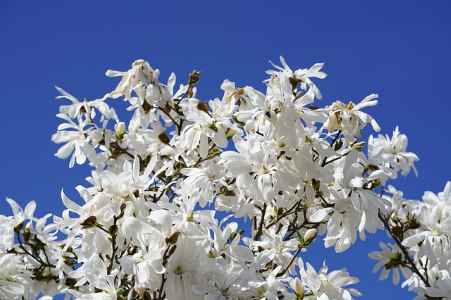
Magnolia trees are one of the most beautiful flowering trees you may choose from. They are little blooming trees with exquisite white blossoms. The Star Magnolia (Magnolia stellata) is a gorgeous white variety that you may want to consider.
The star magnolia is a little tree with star-shaped white blooms that gives it its name. Thin linear-shaped petals radiate out to create a daisy-like flower shape, and these brilliant white flowers are made up of many.
In early spring, star magnolias produce a cloud of delicately scented white flowers.
Fringe Tree

The Fringe tree (Chionanthus virginicus) is a little tree with white scented blooms that grows in the eastern United States. A little flowering tree with mildly scented flowers is known as a fringe tree.
The flower clusters have a bushy, stringy appearance because each flower head is made up of a number of tassel-like petals. One of the reasons why the tree is known as Old Man’s Beard is because of this. The fallen white petals will appear like a blanket of snow beneath the tree after the fringe tree finishes blooming in early summer.
Zone 3–9 is a good zone for these tough shrub-like trees. Fringe trees can grow to be 12 to 20 feet (3 to 6 meters) tall, and you may keep them under control by paying attention to them.
Hydrangea Tree

Several hydrangeas species are little blooming trees, including Hydrangea paniculata ‘Grandiflora’. The white-flowering hydrangea tree is the Hydrangea paniculata ‘Grandiflora’. This little tree, sometimes known as the ‘Pee Gee,’ may reach a height of 10 to 25 feet (3 to 7.5 meters).
Each conical blossomhead is composed of clusters of tiny white flowers and may grow up to 18 inches (45 cm) tall. The tree will be covered in big bushy blooms during the blooming season, which runs from summer to fall.
This big bush can be made to appear like a magnificent specimen tree or an attractive tree by trimming it properly. Even in colder climates, this is a tough blooming tree that can add color to landscapes. Zone 3 through 8 are ideal growing zones.
Hawthorn Tree
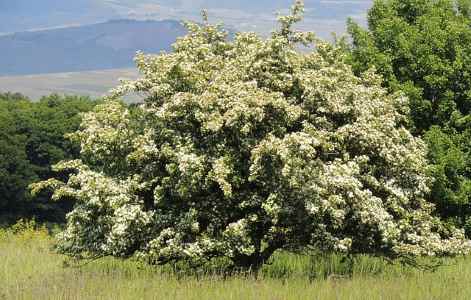
Hawthorn trees produce white, red, or pink blossoms in early summer and are low-maintenance flowers. Hawthorns are very hardy, which is one of the reasons they are popular as flowering trees.
Hawthorn trees are covered in clusters of white flowers when they bloom late in the spring/early summer. Dainty oval petals with pale-yellow stamens make up these flowers. The dark green foliage contrasts beautifully with the bright white blooms.
The popular ‘Washington Hawthorn’ and the thorn-less ‘Winter King’ cultivar are two white hawthorn cultivars available. Throughout the summer and fall, hawthorns produce a variety of colors. Summer brings out the red berries, which become purple before falling. Hawthorn zones range from 4 to 8.
Pear Tree
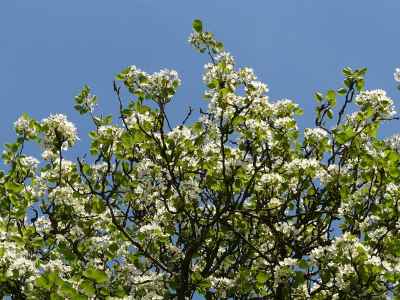
Pear trees produce charming white blooms in the mid to late spring, and they have tiny white blooms that grow in clusters. The entire pear tree is covered in clusters of fragrant pure white blooms while it is in full bloom.
Five little petals, each measuring up to 1.5 inches (4 cm) across, make up each blossom. Pears will begin to develop on the tree after they have finished blooming in early summer.
Late summer and early autumn are usually when these are ready for harvesting. Pear trees reach a height of 12 to 20 feet (3.6 to 6 meters) when fully grown. Dwarf and compact types of flowering pear trees, on the other hand, are a terrific option if you have a small garden.
Japanese Stewartia

Stewartia pseudocamellia is a small to medium-sized flowering tree that blooms white with a yellow center. The tree has a bushy appearance due to the multiple low-branching trunks native to Japan.
In the summer, the tree blooms with cup-shaped white petals and a golden yellow core, producing white flowers. These blooms have a lovely fragance and may grow up to 3 inches (8 cm) broad.
During the summer, the Japanese stewartia produces a lot of white blossoms. If you live in zones 5 through 8 and have well-draining soil in your garden, plant a Japanese stewartia.
Types of Purple Flowering Trees (With Pictures)
Crape Myrtle

The crape myrtle tree (Lagerstroemia) is a huge blooming tree, although there are smaller varieties available. Small, delicate flowers cluster together on petals that are deep purple. From tall trees to tiny to medium-sized trees, and dwarf trees, crape myrtles come in a variety of sizes. shrubs of crêpe myrtle can be found growing.
The purple blooms of crepe myrtle trees are long-lasting and thrive in hot, dry climates. This blooming tree may appear more like a huge blooming shrub because the branches begin low to the ground.
These purple flowers bloom all summer around the tree, forming a conical triangle around it.
Other Lagerstroemia cultivars produce white, red, and pink blooms in addition to purple, which is the most prevalent flower color of crape myrtle. If you live in zones 7 through 10, plant crape myrtle as an ornamental tree in your garden.
Burgundy Desert Willow

The botanical name for little trees known as desert willows is Chilopsis, and they flourish in hot dry environments. These funnel-shaped ruffled flowers are produced by small flowering shrub-like plants. The Bignoniaceae family includes desert willows, which are not related to true willow trees.
Desert willows grow to a height of around 5 feet (1.5 meters) and have a larger cousin that grows to 26 feet (8 meters). From May through September, purple blooms emerge on the tree and release a lovely fragrance.
Desert willows are popular in the United States, including Texas, California, Arizona, and Nevada, and they prefer hot dry climates.
Chaste Tree

The chaste tree (Vitex agnus-castus) is a deciduous shrub-like flowering tree that requires little care and thrives quickly. The blooming tree produces stunning blue or purple blooms and grows quickly and needs little care. Between 4 and 15 feet (1.2 and 4.5 meters) tall, short stocky trees are common.
The lavish floral displays feature 12″ (30 cm) stems with stunning blooms. The gorgeous fragrance of these purple-blue sprays, which seem to erupt from the plant, is a summer treat. From the summer through the beginning of fall, chaste tree flowers should last. In zones 6 through 9, chaste trees flourish.
Jacaranda Tree

Jacaranda trees (Jacaranda mimosifolia or blue jacaranda) are native to subtropical regions, but their magnificent purple blooms have made them popular all over the globe. The blooming trees Jacaranda produce little purple flowers (2 in. / 5 cm) during the spring and early summer.
The length of a Jacaranda tree may reach 66 feet. These flowering trees grow to be tall (20 m), so ensure that your yard has enough room for them.
Purple Orchid Tree (Bauhinia purpurea)
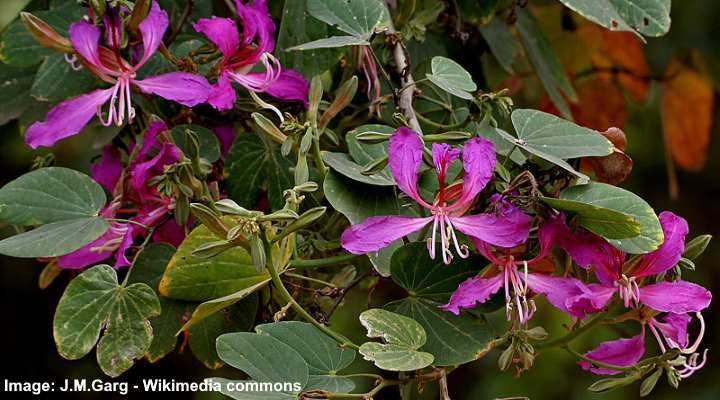
Purple Orchid Tree (Bauhinia purpurea) is a purple flowering tree that blooms from late summer to early winter, with large clusters of beautiful blossoms. With heart-shaped leaves and long brown seed pods, the purple orchid tree is a semi-evergreen tree.
A purple orchid tree grows to be 30 to 35 feet (9 – 10 meters) tall and broad, as a fast-growing flowering tree. The edges of each purple orchid blossom return like a showy orchid blossom, with five petals and frilly borders. White veins, protruding stamens, and a lovely fragrance are all visible on the orchid tree blossoms. Flowers range in diameter from 3 to 5 inches (7.5 to 13 cm).
Just before the leaves fall, purple orchid trees bloom. The leafless limbs of the tree are then adorned with beautiful, showy purple blooms in the autumn. In USDA zones 9 to 11, purple orchid trees flourish. The orchid tree produces large, flat brown seed pods after blooming.
Purple orchid trees have elongated brown seed pods, just like other types of orchid trees. Before opening to disseminate the tiny seeds, these 6″ to 12″ (15–30 cm) long pods harden on the tree.
Other Types of Flowering Trees (With Pictures)
Witch Hazel
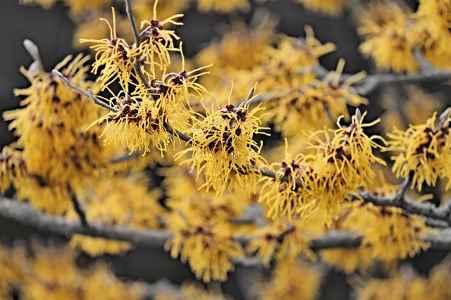
Witch hazels (Hamamelis) are small trees with tiny yellow flowers that are very cold hardy. The bigger kinds may grow into a small tree, despite being classified as shrubs.
On the stems, little yellow blooms grow. Witch hazel is a late bloomer that blooms in the fall, unlike most other flowering trees on this list.
Rose Trees

Roses are a popular flowering shrub that add a beautiful effect to any garden landscape. Grafting and trimming an existing rose shrub, on the other hand, may be used to create a rose tree.
This may lead to the development of a spectacular flowering rose tree that can be grown in pots or as a specimen in your garden.
Plumeria Tree (Frangipani)

Plumeria is a collection of tiny flowering trees and shrubs famous for their fragrant, exotic, showy blooms. Plumeria blooms range in hue from white through yellow, pink, and crimson and are multi-colored.
Frangipani is the name for plumeria trees. Deciduous or semi-evergreen trees and shrubs are the types of tropical trees. Nevertheless, the Plumeria obtusa and Plumeria pudica are two of the few evergreen plumeria tree species.
USDA zones 9 through 12 are ideal for the gorgeous flowering trees. Florida, the Caribbean, the Pacific islands, Mexico, and Central America are all home to these blooming trees.
Frangipani trees, which may grow up to 20 feet (6 meters) tall, are moderate to fast-growing plants. Exotic trees, on the other hand, grow to be between 6 and 8 feet (1.8 and 2.4 meters) tall in most tropical and subtropical garden settings. Sunlight, well-drained soil, water, and fertilizer are all the care plumeria trees need.
Flowering Purple Leaf Plum Tree (Prunus cerasifera)

The purple leaf plum tree (Prunus cerasifera) is a tiny decorative blooming tree with fragrant white-pink spring blooms. Five petals grow in a radial pattern that is 1″ (2.5 cm) across on each lovely, aromatic bloom.
The leaves of the purple leaf plum tree are crimson or purple in hue. At a height of 15 to 25 feet (4.5 to 8 meters), the tiny blossoming tree with dark purple leaves grows. The vase-shaped crown of the deciduous tree is thick and dense.
The purple leaf plum is a popular decorative tree that thrives in moist, well-drained soil and is highly fertile. It’s also known as the cherry plum tree. The attractive dark foliage tree thrives in full sun and may tolerate some shade.
The leaves, on the other hand, become green when there is too much shade. Little plum-like yellow or red edible fruits are also produced by the purple leaf plum tree.
